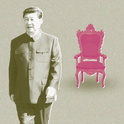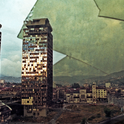At one end of Budapest’s Szabadság Tér (Freedom Place) in late November, 20 people sat listening to a Hungarian activist discuss a recent trip to the United States. He brought up the US election. For him, Hillary Clinton would have been as bad as Donald Trump. “Clinton is militant… the people don’t adore her for it,” he said. Those around him nodded, and hunched up against the cold.
Left-wing activists in Budapest have little faith in American political elites—or their own. Trump’s victory may sanctify the illiberal policies of their own governmental strongman, prime minister Viktor Orbán. Trump and Orbán have superficial similarities, including their use of divisive ideology and anti-migrant sentiment.
But unlike in the US Orbán’s nationalism faces a society with little mainstream left-liberal opposition. As such, Budapest’s small activist population needs to be creative to subvert Orbán, who has tightened his grip on state-funded media and major cultural institutions. In doing so, the activists are rethinking the relationship between citizenship and creativity.
In Szabadság Tér the artists and activists have pitched up a short distance from a memorial to the 1944 Nazi occupation erected by the government in 2014. This kitsch statue, which depicts a bronze imperial eagle (Germany) swooping down on an archangel Gabriel (Hungary), has been widely criticised. Its opponents claim it downplays Hungarians’ complicity in the occupation, and the deportation of hundreds of thousands of Jews during the Holocaust. The statue exemplifies Orbán’s tendency to rewrite Hungary’s complex past along nationalistic grounds.
“We wanted to do something against the plan for the statue [in 2014], and we found the best thing would be to occupy the place of the planned monument,” said Rényi András, one of the founders of Eleven Emlékmu (Living Memorial), and director of the Institute of Art History at Eötvös Loránd University. “Practically and aesthetically, it’s not an appropriate place for a monument. The idea was to organise a flash mob to move people to come here and bring their own personal objects.”
Directly opposite the statue, people have built their own monument: photographs of loved ones, or commemorative mounds of stones, partly in memory of those lost during the war. András’s group cleans the objects, and has put out two white chairs to symbolise alternative forms of dialogue. Its members regularly organise public meetings on the square to protest against what they call the government’s “falsification of history.”
Orbán has appointed loyalists to the Hungarian Academy of Arts (the Magyar Muvészeti Akadémia or MMA), giving him an unprecedented grip on a national conversation that naturally veers towards black and white. Budapest lacks a major contemporary art scene buoyed by the market, and its cultural landscape has historically been reliant on state subsidies—now being selectively cut.
As well as the Freedom Place memorial, Eleven Emlékmu members successfully campaigned last year against a statue of anti-Semitic interwar politician Bálint Hóman in the city of Székesfehérvár. This year the group erected information boards outside the Terror Háza Múzeum (House of Terror)—run by Orbán loyalist Mária Schmidt—after it claimed the museum’s commemorations of the 1956 Hungarian Revolution were skewed towards a nationalist agenda.
Other artists have tackled Orbán’s 2013 ban on rough sleeping in parts of Hungary. Photographer Gabriella Csoszó, a member of the Free Artists movement, which has campaigned against the MMA, runs photography workshops for the homeless at her studio in central Budapest. “This government always needs an enemy, and it has created migrants, homeless people and the poor as its enemy,” she said, speaking at Auróra, a community centre housing local cultural groups and charities. “My sessions teach participants how to avoid clichés of representation and stereotypes. I could take these pictures, but it is better if I show them how.”
Across the city in a café close to the grand Vígszínház Márton Gulyás, a former managing director at the political theatre company Krétakör, said he produces the only dedicated political YouTube show in Hungarian, aired twice weekly. He aims to launch an English version this year. “Our aim is to create a completely independent platform to talk to people directly and tell them the narrative that no-one else does,” he said. He said he wanted to use his film and theatre work to complement this political agenda. “Many of my director contemporaries have lost their relationship with their audience. We have to be community organisers, not representatives, and the same goes for the political opposition today.”
Not every activist I spoke to was convinced that Eleven Emlékmu could go on indefinitely. But back at Szabadság Tér, the meetings continue. As winter sets in, can Eleven Emlékmu march on? “To be frank, the authorities are unable to act,” concluded András. “As time goes by it is more and more demanding for us to maintain the presence on the spot, which the government wants now to forget and make non-existent. Since we are responsible for the installation of the living, we are also somehow in a trap, so we cannot but continue.”

©TTS Studio/REX Shutterstock
Viktor Orbán: How to subvert a strongman
Activists in Hungary are coming up with creative ways to challenge their Prime Minister
January 17, 2017












